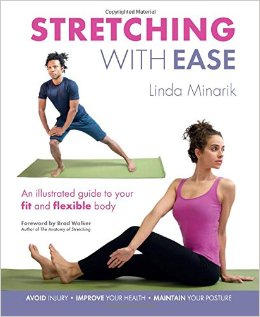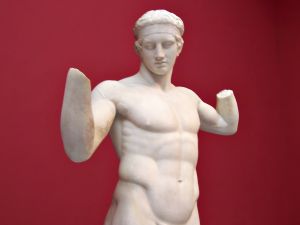 by Brooke Lieb
Linda Minarik is a pianist, dancer, singer, and fitness professional. Her new book is entitled Stretching with Ease. Linda has been familiar with the Alexander Technique for nearly 40 years. Her first private lessons were with ACAT alumna Linda Babits in connection with practicing piano with ease. Linda’s life-long love of movement inspired her to train in ballet, and to become a certified group fitness instructor, including teaching qualifications in Gyrokinesis® and the MELT Method®.
by Brooke Lieb
Linda Minarik is a pianist, dancer, singer, and fitness professional. Her new book is entitled Stretching with Ease. Linda has been familiar with the Alexander Technique for nearly 40 years. Her first private lessons were with ACAT alumna Linda Babits in connection with practicing piano with ease. Linda’s life-long love of movement inspired her to train in ballet, and to become a certified group fitness instructor, including teaching qualifications in Gyrokinesis® and the MELT Method®.
LIEB
Tell us about the inspiration for your book Stretching With Ease.
MINARIK
For a number of years I have been teaching the art of flexibility at a corporate gym facility called Equitable Athletic & Swim Club in mid-town Manhattan. The membership is largely made up of left-brainy people with corporate positions, often high in their chosen professions. Attorneys, doctors, financial wizards, administrative assistants to corporate CEOs—highly articulate people, capable of understanding subtle concepts. They come to class to learn about their bodies; yet fitness is not their field.
I set out to create a worthwhile stretching experience for this fitness audience: teaching them stretching basics while respecting their intelligence. Over the years, I formulated a teaching language that seemed to work. I started explaining as much as I could about why pursuing flexibility might be helpful in their lives, how to allow their bodies to release gently into a stretch, how to align their positions correctly to avoid stressing other body areas, and—a crucial point—exactly where they should be feeling the muscular pull.
Stretching as I teach it emphasizes giving the body adequate time to settle into a position—without rushing into or out of it. Most important is partnering mind with body to increase calmness and minimize fear. Recruit your mind to address your body’s tight spots.
The more I taught, the clearer my instructions became, and my classes began to grow in size. My goal: to clear up the mist of incomprehensibility around flexibility. I wanted to share all the hard-won knowledge I had unearthed over more than two decades of searching. Everyone has his own journey, but I wanted to help people shorten their stretching one.
LIEB
How can stretching contribute to health and well-being, and what are some of the conditions or fitness goals that stretching can help manage or improve?
MINARIK
In some detail, I develop the following benefits of stretching for health, well-being, and fitness improvement in Stretching with Ease:
- Reduces and heals stress
- Prevents injury
- Relieves pain
- Relieves muscular soreness
- Improves posture and body symmetry
- Advances physical and athletic skills
LIEB
You include the Alexander Technique in the “Further Resources” section of your book. When did you first encounter the Alexander Technique, and how has it contributed to your own performing and teaching?
MINARIK
My experience with the Alexander Technique began back in the’70s, when I was beginning to seek better alignment for my body in general, and also physical ease over the many hours I was practicing piano daily for my degree recitals. My study of the Technique long predates my involvement in fitness teaching. Along with other body-work methods, I am sure it was instrumental in making it really easy to start an athletic fitness teaching career in my ‘40s. After taking an introductory group class at a long-forgotten (by me!) studio in the Lincoln Center area, Linda Babits became my first private teacher. A pianist herself, she spent many hours helping me apply the Technique for a pianist’s unique needs. After training with Linda, I also worked extensively with Caren Bayer and Jane Kosminsky.
~
Linda currently teaches group fitness at the New York Health & Racquet Clubs and the Equitable Athletic and Swim Club, both in Manhattan. She pursues classical dance and bodybuilding, and has recently branched out into the study of rhythmic gymnastics, working privately with a former member of the Russian team. Linda is a classically trained pianist, operatic mezzo soprano, and aromatherapist. She lives in New York City. Contact her and/or purchase her book through her website at www.lindasarts.com.
[author] [author_image timthumb='on']http://www.acatnyc.org/main/wp-content/uploads/2014/01/Brooke1web.jpg[/author_image] [author_info]N. BROOKE LIEB, Director of Teacher Certification since 2008, received her certification from ACAT in 1989, joined the faculty in 1992. Brooke has presented to 100s of people at numerous conferences, has taught at C. W. Post College, St. Rose College, Kutztown University, Pace University, The Actors Institute, The National Theatre Conservatory at the Denver Center for the Performing Arts, Dennison University, and Wagner College; and has made presentations for the Hospital for Special Surgery, the Scoliosis Foundation, and the Arthritis Foundation; Mercy College and Touro College, Departments of Physical Therapy; and Northern Westchester Hospital. Brooke maintains a teaching practice in NYC, specializing in working with people dealing with pain, back injuries and scoliosis; and performing artists. www.brookelieb.com[/author_info] [/author]

 by Witold Fitz-Simon
I’ve been noticing over the past few weeks how a few of my Facebook friends have signed up to be part of an event for the month of June: "30 Day Ab Challenge for those who need some motivation like me.” I clicked over to the event page and was surprised that 1.9 MILLION Facebook users have said they are going to take part. I work both as an Alexander Technique teacher and a Yoga teacher, so I spend a certain amount of my working week in gyms. I understand the pressure to look trim and have a slim waist, and I see the effort people put in to the goal of hard abs. I also see the harmful effects this can have on them. Tight abs can be really bad for the body, and here are five reasons why:
by Witold Fitz-Simon
I’ve been noticing over the past few weeks how a few of my Facebook friends have signed up to be part of an event for the month of June: "30 Day Ab Challenge for those who need some motivation like me.” I clicked over to the event page and was surprised that 1.9 MILLION Facebook users have said they are going to take part. I work both as an Alexander Technique teacher and a Yoga teacher, so I spend a certain amount of my working week in gyms. I understand the pressure to look trim and have a slim waist, and I see the effort people put in to the goal of hard abs. I also see the harmful effects this can have on them. Tight abs can be really bad for the body, and here are five reasons why: